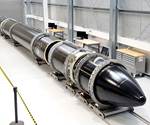Rocket Lab launches 7 payloads into orbit
The mission, named “It’s Business Time,” marks Rocket Lab’s second successful orbital launch of its all-composite Electron launch vehicle.
Rocket Lab (Aukland, New Zealand) launched seven payloads to orbit on Nov. 11. The mission, named “It’s Business Time,” marks Rocket Lab’s second successful orbital launch of its all-composite Electron launch vehicle and deployment of customer satellites.
Satellites were deployed for Spire Global (San Francisco, CA, US), Tyvak Nano-Satellite Systems (Irvine, CA, US), Fleet Space Technologies (Beverly, Australia) and the Irvine CubeSat Stem Program (ICSP, Irvine, CA, US). Curie also carried NABEO, a drag sail technology demonstrator, designed and built by High Performance Space Structure Systems GmbH (Munich, Germany), to passively de-orbit inactive small satellites and reduce space junk.
Rocket Lab founder and chief executive Peter Beck says the mission marks a new era in access to space. “With two orbital launches down for 2018, we’re not resting on our laurels,” says Beck. “We have a burgeoning customer manifest, so we’re moving onto the next mission within a few weeks – the incredibly exciting ELaNa 19 mission for NASA in December.”
Rocket Lab is poised for high-frequency launches in 2019 with production facilities designed to enable mass Electron production, and a private launch complex licensed to launch up to 120 times per year.
Related Content
-
Plant tour: Spirit AeroSystems, Belfast, Northern Ireland, U.K.
Purpose-built facility employs resin transfer infusion (RTI) and assembly technology to manufacture today’s composite A220 wings, and prepares for future new programs and production ramp-ups.
-
Welding is not bonding
Discussion of the issues in our understanding of thermoplastic composite welded structures and certification of the latest materials and welding technologies for future airframes.
-
Cryo-compressed hydrogen, the best solution for storage and refueling stations?
Cryomotive’s CRYOGAS solution claims the highest storage density, lowest refueling cost and widest operating range without H2 losses while using one-fifth the carbon fiber required in compressed gas tanks.












